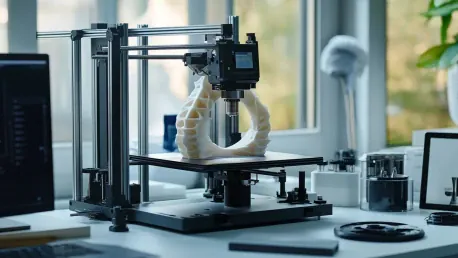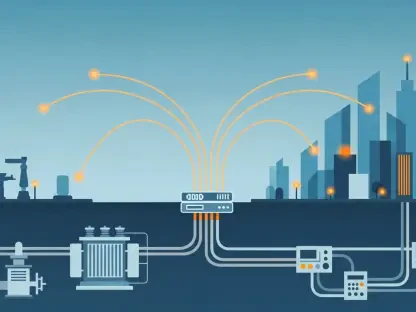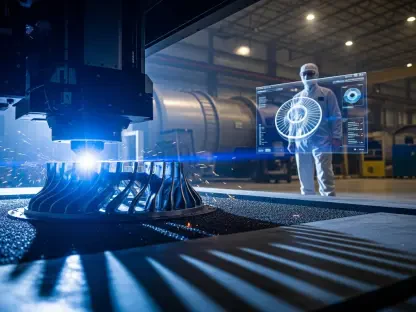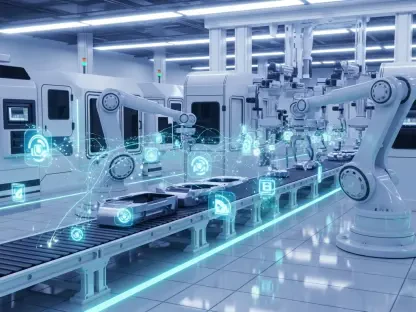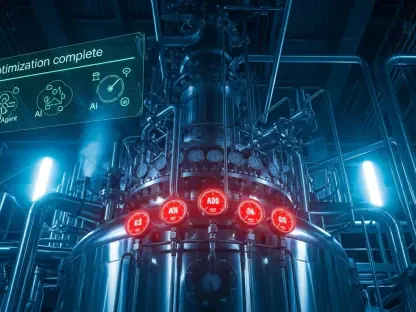The future of 3D printing, also known as additive manufacturing, is set to significantly reshape various industries by integrating advanced technology such as CAD (Computer-Aided Design), AI (Artificial Intelligence), and IoT (Internet of Things). Analysts note that digital manufacturing, which heavily relies on 3D printing, is undergoing rapid expansion. Projections suggest it will reach a value of $0.44 trillion by the end of this year and grow at a CAGR of 19.40% over the next five years, potentially hitting $1.07 trillion by 2030. This process enhances performance, efficiency, and precision in the manufacturing sector.
What is Additive Manufacturing?
Definition and Process
Additive manufacturing refers to the process of creating an object by building it layer upon layer, a method that starkly contrasts with subtractive manufacturing, where an item is created by chiseling away at a larger block of material. This method’s versatility allows for utilizing various materials, including polymers, metals, ceramics, concrete, foams, gels, and even biomaterials. Each 3D printer employs different strategies, such as lasers, special hardening powders, and ovens, to construct the final product. The layer-by-layer approach not only enhances precision but also offers the flexibility to produce complex geometries that would be impossible with traditional methods.
How Additive Manufacturing Works
The process begins with a design. CAD software or a 3D scanner provides the digital input for the layer framework protocol, which translates the design into slivers that the 3D printer can comprehend. Typically, a nozzle adds successive layers of material matching the design. The material hardens due to chemical reactions, heat, or other factors, depending on the specific 3D printing process being used. The system’s ability to accurately replicate digital designs in physical form has made it invaluable in rapid prototyping, allowing for swift iterations and adjustments.
Multiple Ways to 3D Print
Diverse Methods and Applications
Several 3D printing methods exist, each suitable for different sizes and requirements. Some specialty printers can create microscopic pieces or intricate electrical components, while others are capable of constructing entire neighborhoods. This range of printing processes means that 3D printing can take anywhere from hours to days, depending on the print’s complexity. For instance, Fused Deposition Modeling (FDM) is often used for simple, rapid prototypes, whereas Selective Laser Sintering (SLS) and Stereolithography (SLA) are preferred for high-resolution, detailed prints. Some systems can print using multiple materials, although this often necessitates a curing time between material applications.
Innovative Approaches
One groundbreaking method involves using holographs to print through the skin, offering potential applications in medical fields. This technology could repair parts without disassembly or even print organs directly in place. This non-invasive approach could revolutionize surgeries and medical treatments, reducing recovery times and enhancing precision. Another innovative technique includes multi-material printing, allowing for the creation of hybrid structures with varying mechanical properties, essential for advanced engineering and biomedical applications.
Benefits of Additive Manufacturing
Cost Savings
Additive manufacturing offers numerous benefits, including significant cost savings. It reduces costs across the board by enabling on-site creation of products, thereby cutting down on shipping and third-party prototyping expenses. The ability to produce components on-demand also minimizes inventory costs and reduces the need for large storage spaces. Additionally, the precision of 3D printing reduces material wastage, which is a considerable expense in traditional manufacturing processes. This economic efficiency makes additive manufacturing an attractive option for both small businesses and large corporations.
Flexibility and Sustainability
Designers can use a broad selection of materials to create unique, functional, or stand-alone designs. This flexibility allows for the rapid development and testing of prototypes, accelerating the innovation cycle. Moreover, additive manufacturing significantly reduces waste material and potentially uses recycled materials, making it more environmentally friendly. The layer-by-layer approach ensures that only the necessary amount of material is used, and many industries are exploring the use of biodegradable or recyclable materials to further enhance sustainability. This eco-friendly aspect is increasingly important as industries strive to reduce their environmental footprint.
Historical Context and Key Moments
Early Developments
The concept of 3D printing dates back to as early as 1977, with significant advancements occurring in the 1980s and beyond. In the 1980s, the first patent for stereolithography (SLA) was filed, laying the groundwork for future developments. Notable milestones include Wake Forest engineers successfully 3D printing a bladder in 1999, marking the first instance of 3D printing an organ. This landmark event demonstrated the potential of additive manufacturing in medical applications, paving the way for further research and innovation in bioprinting.
Practical Applications
The technology continued to evolve with more practical applications, such as the University of Michigan’s 3D-printed splint that saved a child’s life and Boeing’s use of FAA-approved 3D-printed titanium parts for its Dreamliner planes. These advancements showcased the versatility and reliability of 3D printing in critical, real-world scenarios. The success of these applications has inspired further investments and research into new materials and methods, broadening the scope of what can be achieved with additive manufacturing.
Future Prospects
Non-Invasive Surgeries
The future of additive manufacturing appears promising, with potential applications like non-invasive surgeries using holographic sound waves to print devices through the skin. This technology is expected to become more prevalent across various industries, including aerospace, healthcare, automotive, and construction. The ability to perform precise, non-invasive procedures could revolutionize medical treatments, making surgeries less traumatic for patients and reducing recovery times. Additionally, industries like aerospace and construction stand to benefit from the ability to create complex structures and components with unparalleled accuracy.
Industry Applications
Aerospace
The aerospace industry benefits from 3D printing lightweight composite pieces that offer stability and durability. Boeing and General Electric already utilize additive manufacturing for multiple aircraft components. These parts can be tailored for optimal performance, reducing weight and increasing fuel efficiency. The ability to produce complex geometries with minimal waste also contributes to cost savings and environmental sustainability. As the technology advances, it is likely to become even more integral to the aerospace sector, enabling the creation of more advanced and efficient aircraft designs.
Healthcare
Inroads have been made in creating customized products like prosthetics and implants. The ability to tailor medical devices to individual patients’ needs enhances comfort and functionality. In the future, 3D printers might be present in ambulances and local pharmacies, enabling rapid production of medical devices on-site. This could transform emergency medical care and improve access to essential medical supplies in remote or underserved areas. The potential for bioprinting tissues and organs also holds promise for advancing regenerative medicine and addressing the shortage of donor organs.
Automotive
As electric vehicles (EVs) become more popular, manufacturers are turning to 3D printing to produce lighter components, extending vehicle range and performance. The ability to create complex, lightweight structures that optimize aerodynamics and reduce energy consumption is crucial for advancing EV technology. Additionally, 3D printing allows for rapid prototyping and customization, enabling manufacturers to quickly adapt to changing consumer demands and regulatory requirements. This flexibility and efficiency make additive manufacturing a valuable tool in the transition to more sustainable transportation solutions.
Construction
Entire neighborhoods have been successfully printed using massive 3D printers that employ different materials, including concrete and compacted dirt. 3D printing in construction offers the potential to reduce costs, minimize waste, and accelerate building times. This technology can also create more complex and resilient structures, incorporating innovative designs and materials that enhance sustainability and performance. As the construction industry faces challenges related to labor shortages and environmental impact, additive manufacturing provides a promising solution for building the cities of the future.
Investment Trends
Emerging Trends
Several investment trends are emerging in the 3D printing sector, including materials, software, and core components. Companies like Stratasys, Desktop Metal, and Velo3D are recognized as industry leaders. Investment in research and development continues to drive innovation, with new materials and techniques being developed to expand the capabilities of 3D printing. The focus on software advancements also plays a crucial role, enabling more precise control and optimization of the printing process. As the technology matures, investment trends are likely to shift towards applications and integration, further solidifying additive manufacturing’s role in various industries.
Consolidation and Drones
Significant consolidation is expected in the sector, with larger conglomerates potentially looking internally to meet their 3D printing needs. This trend suggests that the industry may see mergers and acquisitions as companies seek to enhance their capabilities and market share. The rise of drones is also driving demand for 3D-printed parts. Drones require lightweight, durable components that can only be efficiently produced through additive manufacturing. This demand is expected to grow as the use of drones expands in fields such as logistics, surveillance, and agriculture, creating new opportunities for the 3D printing industry.
Barriers to Adoption
Material Limitations
Despite its promise, several barriers slow the widespread adoption of additive manufacturing. Engineers must understand stress points created during the 3D printing process to avoid failures. Material limitations also play a significant role, as not all materials can be easily adapted for 3D printing. The development of new materials that are compatible with additive manufacturing technologies is an ongoing challenge. Additionally, the mechanical properties of 3D-printed parts can vary, requiring extensive testing and validation to ensure reliability and safety in critical applications.
Costs
Industrial-grade 3D printers can be expensive and require significant space, making them more suitable for small-scale production rather than massive operations. The initial investment in equipment and training can be a barrier for many organizations. Furthermore, the cost of materials used in 3D printing can be high, particularly for specialized applications requiring advanced composites or metals. Despite these challenges, ongoing advancements in technology and economies of scale are expected to reduce costs over time, making additive manufacturing more accessible to a broader range of industries.
Conclusion
The future of 3D printing, also known as additive manufacturing, is on the cusp of transforming numerous industries by incorporating advanced technologies like CAD (Computer-Aided Design), AI (Artificial Intelligence), and IoT (Internet of Things). This evolution is poised to significantly enhance performance, efficiency, and precision within the manufacturing sector. Analysts note that digital manufacturing, which heavily relies on 3D printing, is undergoing rapid expansion. It’s forecasted that the market will attain a value of $0.44 trillion by the conclusion of this year. Moreover, projections indicate a compound annual growth rate (CAGR) of 19.40% over the coming five years, with potential for the market to reach a staggering $1.07 trillion by 2030.
The implications of this growth are profound, offering transformative potential across industries such as healthcare, automotive, aerospace, and construction. In healthcare, for instance, personalized medical devices and prosthetics can be produced with unprecedented precision. In the automotive sector, complex parts can be manufactured with greater efficiency and less material waste. The aerospace industry benefits from the ability to produce lightweight components, leading to improved fuel efficiency. Construction can leverage 3D printing to create sustainable building materials and structures. As 3D printing technology continues to evolve, its impact on various sectors is expected to expand, providing innovative solutions and driving progress in manufacturing worldwide.
